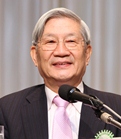Turbulent World Situation and Japan
May 30, 2012
Mr. Makoto Iokibe
Chairman, Reconstruction Design Council, Reconstruction Agency Chancellor, Prefectural University of Kumamoto
 Japan achieved the world��s best manufacturing technology and its industrial products enjoyed superior competitiveness in the post-cold war 1980s. As we entered the 1990s, however, US took the lead in IT globalization and the Japanese competitive edge started to ebb away. The so-called ��Lost Decade�� got prolonged to over 20 years and then, the Great East Japan Earthquake hit Japan which to some people might be the final blow.
Japan achieved the world��s best manufacturing technology and its industrial products enjoyed superior competitiveness in the post-cold war 1980s. As we entered the 1990s, however, US took the lead in IT globalization and the Japanese competitive edge started to ebb away. The so-called ��Lost Decade�� got prolonged to over 20 years and then, the Great East Japan Earthquake hit Japan which to some people might be the final blow.
��As I am a historian, let me tell you that Japan has developed by overcoming many setbacks, failures and national crises. Japanese history is the record of numerous breakthroughs.
��An old example is the ��Battle of Baekgang�� that broke out in 663. The Yamato court deployed large-scale troops of 27,000 soldiers to the Korean Peninsula which were completely defeated. The Yamato court predicted the invasion from Tang and Silla and formulated various security countermeasures. A huge network of shore fortifications was established from Tsushima Island to Takayasu fortress, while frontier guards were deployed and a communication system of signal fires was designed.
��What was more, the Japanese people strove to learn as much as possible from the superior civilization of the Tang Dynasty and established the Heijo-kyo in 710 after 50 years of hard work, which replicated the rigorous administrative system of the Chinese dynasty. This symbolizes the Japanese civilization reached the level of the world in the 8th century.
��The first and last full-scale foreign invasion was made by the 14,000-strong- troops from Mongolia in the 13th century. Some say the kamikaze (Divine Wind) destroyed much of the Mongol fleet, yet the real reason for victory was that Japanese worriers prevented the Mongol troops from disembarking and establishing their bridgehead. It proves the military potential of the Japanese forces was as strong as that of Mongolia, in spite of different fighting styles they had engaged. It was also the first instance for the samurai clans to fight against foreign troops rather than amongst themselves.
��Japanese history plunged into turmoil from the Onin War throughout the Sengoku (Warring States) Period over 150 years, where there was no peace, governing structure nor order. Oda Nobunaga, Toyotomi Hideyoshi and Tokugawa Ieyasu initiated the unification of Japan under the Shogunate and brought long-lasting peace over 270 years. History proves the Japanese society is endowed with the power of restitution.
��Arrival of the black ships in 1853 shocked the Japanese who had enjoyed peace behind its self-isolation policy. Japan lagged behind Western countries that had undergone the Industrial Revolution. Encounter with the well-advanced Western civilization overwhelmed the Japanese. The Shogunate as well as the Meiji Government realized the only way for Japan to survive was to learn from and assimilate into the superior modern Western civilization. Iwakura Mission symbolizes the eagerness of Japanese people to acquire secrets behind superior abilities.
��Japan failed to keep up with the massive changes in the international environment during the early 20th century. Being the only country equipped with modernized military forces in Asia, Japan engaged in fights against Britain and US in 1941 and suffered devastating air-raid damages in 1945.
��Contrary to all expectations, Japan made a miraculous recovery of high growth in just 20 years and became the world��s best manufacturing country in 40 years to form the Japan-Europe-US trilateral framework. We demonstrated how successfully we could overcome national crises and hardships.
��As I chair the Reconstruction Design Council for the Great East Japan Earthquake, I envision Japan to spring up before we fall into real defeat. I believe the 3.11 Earthquake demonstrated the toughness of our country. Earthquake survivors remained composed, disaster-response personnel showed their superior capabilities and the Self Defense Forces operated with great dedication.
��We realized anew the enormous damage tsunamis could inflict. 120,000 houses were washed away and 400,000 people were forced to evacuate. It claimed the lives of 20,000 people, yet considering its massive scale, I think the number of casualties was relatively small thanks to the repeated tsunami drills that taught us to escape.
��The Reconstruction Design Council aims to formulate reconstruction measures that would draw a new page in history. For example, we recommended a new model to relocate homes and core urban functions to a safe location on higher ground. The Ministry of Land, Infrastructure, Transport and Tourism will implement the Collective Relocation Promotion Project for Disaster Prevention. The government will shoulder necessary costs for reconstruction, which are estimated to total 20 trillion yen.
��Speaking about economic resources, I must say Japan will plunge into chaos if the Strait of Hormuz is blockaded and the operation of all the nuclear reactors in our country is suspended. I think the feasible scenario is to keep operating nuclear reactors for a certain time, while improving their safety.
Before closing, let me state that China has the world��s second largest economy today and it has taken aggressive actions to increase its maritime interests. Increasing military presence of China poses us critical questions on how to deal with this enormous country.